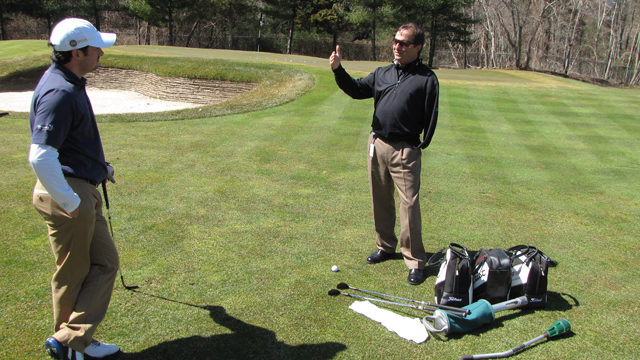NEWS
Golf Club Fitting: What golf ball best suits your game? (Part III)

PGA.com's T.J. Auclair recently took a trip to "Manchester Lane," in Acushnet, Mass., better known as the "Titleist Test Facility." While there, Auclair went through a club-fitting with PGA Professional Karen Gray, Titleist Supervisor of Player Research. Titleist Player Research Representatives Alex Stimpson and Bubba Kroeger were there to assist Gray. Following the club fitting, Auclair went through a golf-ball fitting with Gray and Titleist Golf Ball Fitting Manager Mike Gibson. This is the third and final installment of the three-part series on the complete fitting experience.
PGA.com's club fitting series: Part I | Part II | Part III | Club fitting Q&A | Photo Gallery
ACUSHNET, Mass. -- A golf club fitting, you might be surprised to know, isn't complete without a proper golf ball fitting.
A golf ball fitting is a lot more important than you probably think.
“There is only one piece of equipment that you use on every shot, your golf ball,” explained Mike Gibson, Titleist Golf Ball Fitting Manager. “Getting fit for your golf ball, and playing that golf ball exclusively, eliminates the performance variation and will help you hit more greens in regulation and hit the ball closer to the pin to convert more putts.”
Karen Gray (PGA Professional and Titleist Supervisor of Player Research), Gibson and I jumped into a golf cart and drove down a path, deeper into the woods to the breathtaking short-game area at Manchester Lane. Just 100 yards in length, the short-game area features a plush, wide fairway to offer an array of shot types, healthy rough and demanding bunkers that protect an undulating green.
Gibson had me start 40 yards from a tucked pin -- a ½ sand-wedge shot for me. Before hitting any shots, Gibson explained how important it is to find a proper ball based on how a ball reacts to your scoring clubs – your wedges. While everyone wants more yardage off the tee, Gibson explained you’re only going to hit 14 driver shots max throughout the course of a round. Why then would you get a ball based on your driver?
If you’re playing a golf ball that’s designed for distance, Gibson explained, that ball may not give you the greenside performance you’re looking for. Sure, you’ll hit it further, but without feel around the greens that particular ball won’t be lowering your scores – the ultimate goal.
READ: Titleist 913 Drivers boast playability, forgiveness
READ: Titleist teases prototype 712U utility irons
READ: Titleist gives first look at 714 series irons
“Short-game shots are where you have the greatest opportunity to lower your score, so it’s important to select a golf ball that performs best for your scoring shots. In a fitting, you must get fit for your irons and scoring clubs such as the wedges first, and then fit the driver to that ball for the best results.”
As I hit soft wedge shots into the green, Gibson said his focus was listening to the sound the varying golf-ball models made coming off the clubface and then watching to see how they reacted once they landed on the green.
We moved up and went through the same routine from just in front of the green and also from the greenside bunkers.
“Off the tee with the driver, golf balls are more similar than different and most golfers do not notice any noticeable difference in distance, feel, spin and launch,” Gibson said. “However, shots played into or around the green are more different than similar. If you’re playing a golf ball that doesn't offer you adequate spin to a tight pin placement, then your putting average goes up because you are starting farther away from the hole. You know the adage, ‘If you want to be a great putter, hit the ball closer to the hole.’ Also, a properly fit golf ball will make you more consistent because you will know exactly how far your golf ball will go on every shot and how your golf ball will react into or around the green.”
There’s an evaluation Gibson uses to determine the ball that best fits a particular player.
First, he has the player choose two golf ball models they believe to be best suited for their game.
Second, take the two golf balls to the golf course for the on-course evaluation process, executing all shots using both golf ball models.
Finally, there’s a chart used to track which golf ball performs best for each type of shot.
There are five things to consider when comparing the golf balls:
- Score
- Proximity to the pin
- Greens hit
- Fairways hit
- Feel preference
“The first thing that we need to know is where the golfer needs the most help.,” Gibson said. “Are they looking to improve their greens in regulation averages, or looking for a more controllable scoring-shot performance, or just looking for a golf ball that answers their preference needs? If it is a performance need, then we focus on how the golf ball reacts to their swing. Conditions such as launch, spin and speed are observed and assessed. We find that most golfers lack shot spin and control into the green so a performance golf ball is recommended such as Pro V1 or Pro V1x.”
Again, one of the easiest ways to shave strokes off your game is to use the proper tools. You’ll be amazed at the process. A day later, with credit card in hand, I placed my order with the specs recommended by Gray and her team. Perhaps the most amazing part of a club fitting that people don’t understand is this: Your properly fit clubs will cost you little – if anything – more than what you’d pay off the rack.
See your local PGA Professional to learn what is best for you and why.
Follow T.J. Auclair on Twitter, @tjauclair.
